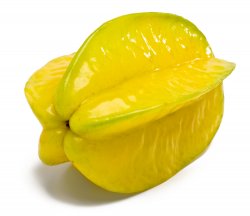Passion Fruit:

The passion fruit has a sweet, aromatic flavour, and tastes much better than it looks! It is a very simple fruit to eat; you just need to cut it in half and scoop out the pulp. You can eat it on its’ own or use it as a topping for ice cream, add to a drink, or whatever you can think of!

Passion fruit is native to Brazil and is actually considered to be a berry. When ripe, the leathery, purple-brown skin becomes brittle and wrinkled, and the pulp is yellow in colour with a jelly-like texture that contains edible seeds. The pulp has a lemony, tart flavour and very much matches the smell of the fruit.
When I tasted the passion fruit, I admit, it took a minute for me to work up the courage to taste it. It did not look appealing to me at all, but I knew that I had to try it and get it over with, and I’m glad I did! I got past the look of the fruit and quite enjoyed the taste of it. I decided to put it over a raspberry sherbet that I had, and it turned out great!

(I know this doesn’t look all that appealing, but it was delicious!)
Granadilla:

Granadillas are a variety of the passion fruit, so I decided to combine the two into one post!
When trying the granadilla, I had a bit of the same difficulty with working up the courage to eat it. I noticed the texture a lot more than the taste itself. When I did notice the taste, I noticed that it is not nearly as tart as the passion fruit, but it has a strange after taste that I could not describe.
The texture of the fruit is what turned me away from this fruit the most. The seeds are surrounded by a jelly-like pulp similar to the passion fruit, but I found this pulp to me much thicker, as well as the seeds are a lot crunchier. Overall, I did not enjoy eating this fruit and found the appearance of the seeds of the granadilla to be less appealing than those of the passion fruit.
Cutting the Granadilla:
The outer shell of the granadilla is quite hard, and though I found instructions to cut it in half, I ended up cracking the outer shell a bit and breaking away little pieces at a time. After breaking away most of the shell, I started to gently tug at the seeds and they all fell out at the same time! The inside of the shell had a coral like appearance, which held all the seeds in place quite nicely. This was definitely the coolest part for me to see, and I enjoyed cutting open this fruit.





If anyone has tried these fruits, I’d love to hear what your opinions are of them!









































